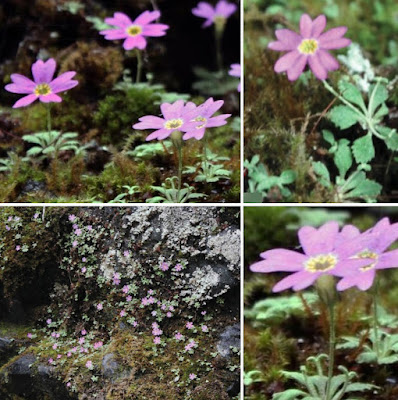[Most Recent Entries] [Calendar View]
Tuesday, September 14th, 2021
| Time | Event | ||||
| 1:28a | [Botany • 2021] Primula dujiangyanensis (Primulaceae) • A New Species from Sichuan, Southwest China
Abstract Primula dujiangyanensis, a new species from Dujiangyan, Sichuan of China, is described and illustrated here. The new species is morphologically similar to P. kialensis and P. pengzhouensis, but it can be distinguished from the latter species by dense white hairs at roots, long stolons, smaller plants and leaves, solitary scape arising from leaf rosette, single lanceolate bract, and shorter pedicel, and it also showed different positions of anthers and styles in the corolla tube. Keywords: Eudicots, endemic species, Primula sect. Aleuritia, taxonomy
Primula dujiangyanensis W.B.Ju, Bo Xu & X.F.Gao, sp. nov. Diagnosis:— Primula dujiangyanensis is similar to P. kialensis Franchet (1895: 450) and P. pengzhouensis C.M.Hu, G.Hao & Y.Xu in Xu et al. (2017: 229), but it can be easily distinguished from them by the smaller plant size, stolons 3–6 cm long, roots densely white hairy, scape unitary, inflorescence with single lanceolate bract ca. 0.5–1 mm long, pedicel 3–6 mm long, and stamens of pin flower in middle of corolla tube and stamens of thrum flower at the mouth of corolla tube, the shorter style reaching middle of tube, the longer style slightly exceeding the corolla tube mouth. Etymology:— The specific epithet refer to Dujiangyan City, the administrative name of the type locality. Wen-Bin Ju, Heng-Ning Deng, Da-Hai Zhu, Yun-Dong Gao, Xin-Fen Gao and Bo Xu. 2021. Primula dujiangyanensis (Primulaceae) discovered from Sichuan, Southwest China. Phytotaxa. 510(3); 275–280. DOI: 10.11646/phytotaxa.510.3.7 | ||||
| 6:00a | [Ichthyology • 2021] Phylogeography of Baryancistrus xanthellus (Siluriformes: Loricariidae), A Rheophilic Catfish Endemic to the Xingu River Basin in eastern Amazonia
Baryancistrus xanthellus (Loricariidae) is an endemic fish species from the Xingu River basin with its life history in the shallow rapid waters flowing over bedrock substrates. In order to investigate the genetic diversity and demographic history of B. xanthellus we analyzed sequence data for one mitochondrial gene (Cyt b) and introns 1 and 5 of nuclear genes Prolactin (Prl) and Ribosomal Protein L3 (RPL3). The analyses contain 358 specimens of B. xanthellus from 39 localities distributed throughout its range. The number of genetically diverged groups was estimated using Bayesian inference on Cyt b haplotypes. Haplotype networks, AMOVA and pairwise fixation index was used to evaluate population structure and gene flow. Historical demography was inferred through neutrality tests and the Extended Bayesian Skyline Plot (EBSP) method. Five longitudinally distributed Cyt b haplogroups for B. xanthellus were identified in the Xingu River and its major tributaries, the Bacajá and Iriri. The demographic analysis suggests that rapids habitats have expanded in the Iriri and Lower Xingu rivers since 200 ka (thousand years) ago. This expansion is possibly related to an increase in water discharge as a consequence of higher rainfall across eastern Amazonia. Conversely, this climate shift also would have promoted zones of sediment trapping and reduction of rocky habitats in the Xingu River channel upstream of the Iriri River mouth. Populations of B. xanthellus showed strong genetic structure along the free-flowing river channels of the Xingu and its major tributaries, the Bacajá and Iriri. The recent impoundment of the Middle Xingu channel for the Belo Monte hydroelectric dam may isolate populations at the downstream limit of the species distribution. Therefore, future conservation plans must consider the genetic diversity of B. xanthellus throughout its range. Keila Xavier Magalhães, Raimundo Darley Figueiredo da Silva, André Oliveira Sawakuchi, Alany Pedrosa Gonçalves, Grazielle Fernanda Evangelista Gomes, Janice Muriel-Cunha, Mark H. Sabaj and Leandro Melo de Sousa. 2021. Phylogeography of Baryancistrus xanthellus (Siluriformes: Loricariidae), A Rheophilic Catfish Endemic to the Xingu River Basin in eastern Amazonia. PLoS ONE. 16(8): e0256677. DOI: 10.1371/journal.pone.0256677 |
| << Previous Day |
2021/09/14 [Calendar] |
Next Day >> |





